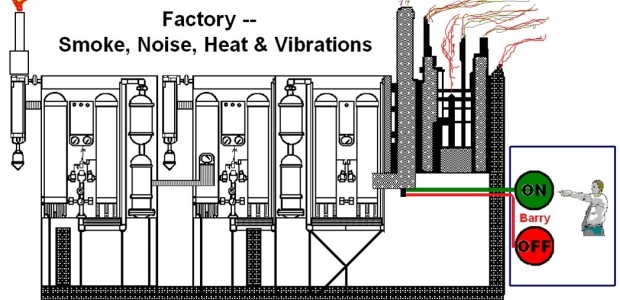
Employee Protection: The Hierarchy of Controls
"Replace the methylene chloride with any of the newer paint strippers that are less toxic, and your employees are able to work safely."
"Hello, Barry. I have another question for you," said Jerry Laws, editor of Occupational Health & Safety magazine.
"Hello to you, too," I said. "What can I do for you?"
Jerry explained that he was talking to a group of students, and one said that giving an employee a respirator was the best way to protect them from a chemical hazard. He said he remembered my telling him something about controls and employee protection, but he could not remember what it was. What should he tell the student?
"Sure, Jerry, it is rather easy to explain. Your employees have a task. Let us say they have to work on a machine that makes smoke, a lot of heat, some noise and vibrations. What are they exposed to?" I asked.
"I would guess that it is what the machine is putting out--smoke, heat, noise, and vibrations."
"Correct, my friend. Now, how would you protect them from each of those hazards?"
"What if you give them some PPE?" Jerry said. "What PPE would that be? Do they need anything else?"
"PPE may sound good but it is not the best way to protect them. OSHA has something called the hierarchy of controls. This hierarchy provides different levels of protection, depending upon the work the employees have to do. At the top of the hierarchy is elimination or substitution. If you can eliminate the smoke, heat, noise, or vibration, there is no exposure to any hazard. If you were using methylene chloride, for example, as a paint stripper, you would be exposing your employees to a carcinogen. Replace the methylene chloride with any of the newer paint strippers that are less toxic, and your employees are able to work safely."
"For our machine, they need to work around it so we can't eliminate the machine and its hazards. What else can we do?" I continued. "OSHA has giving us the answer with this hierarchy that's on their website."
"The next step in the hierarchy is engineering controls. With engineering controls, we are making physical changes to the workplace to protect the employees without them having to think about what has to be done for their protection. When we talk about using PPE, the employee has to think about what they need. Can you imagine that your boss said, 'Jerry, I want you to make a solution of ammonium hydroxide. One part of the concentrate to 10 parts of water.' What type of PPE do you need?
"Let's go from the top down . . . hard hat?"
"Probably not," Jerry said.
"What about face protection?"
"I would need some safety glasses," Jerry said, "but I'm not sure if I need a faceshield."
"Respiratory protection?"
"Yes, definitely, because ammonium hydroxide has a strong odor."
"Okay, but what type of cartridges or filters?" I asked.
"I'm not sure. How about the pink ones?"
I said, "We can stop right here. Do you see how confusing it is for the employee? We need some very specific instructions in the form of an SOP that tells the employees exactly what PPE to use and when. Then they need to be trained before they use it, and that training has to be kept current.
"Let's look at our machine, and let's say that I'm the operator. You already told me that I am exposed to the smoke, noise, heat, and vibrations that the machine puts out while I am operating it. How are you going to protect me?"
Jerry hesitated, then asked, "Are we going to have to physically change the machine?"
"Partly correct. We are going to change something, but it is not the whole machine. We really cannot stop it from making the smoke, noise, heat, and vibrations because that is how it functions. What we are going to change is how I operate the machine. If we move the controls away from the machine, we can put them into a small, environmentally controlled booth. That way, I am protected from all of the smoke, noise, heat and vibrations, but I can still see the operations of the machine. In addition, I do not have to think about what type of protective equipment, if any, I need to use. The second picture here shows me at the new controls."
"In my control room, I am protected from all of the hazards," I said.
"Our last section is administrative controls or work practices. These are not as protective as the two above, because it is up to outside influences to protect the employees," I added. "For example, it is going to take several weeks to put those controls on the machine, but the company wants to protect us now. So they set up an administrative control: Jerry works the morning hours and I work the afternoon hours. When we are not working on the machine, we are filling in the rest of our time working in other departments. In addition, they want us to stay hydrated because of the heat, so they post signs that say, 'Hydration Station/Hydrated = Happy & Healthy.' This is a work practice.
"At the bottom of the hierarchy is personal protective equipment and we have already talked about why it is last. There you have it, Jerry."
This article originally appeared in the November 2014 issue of Occupational Health & Safety.